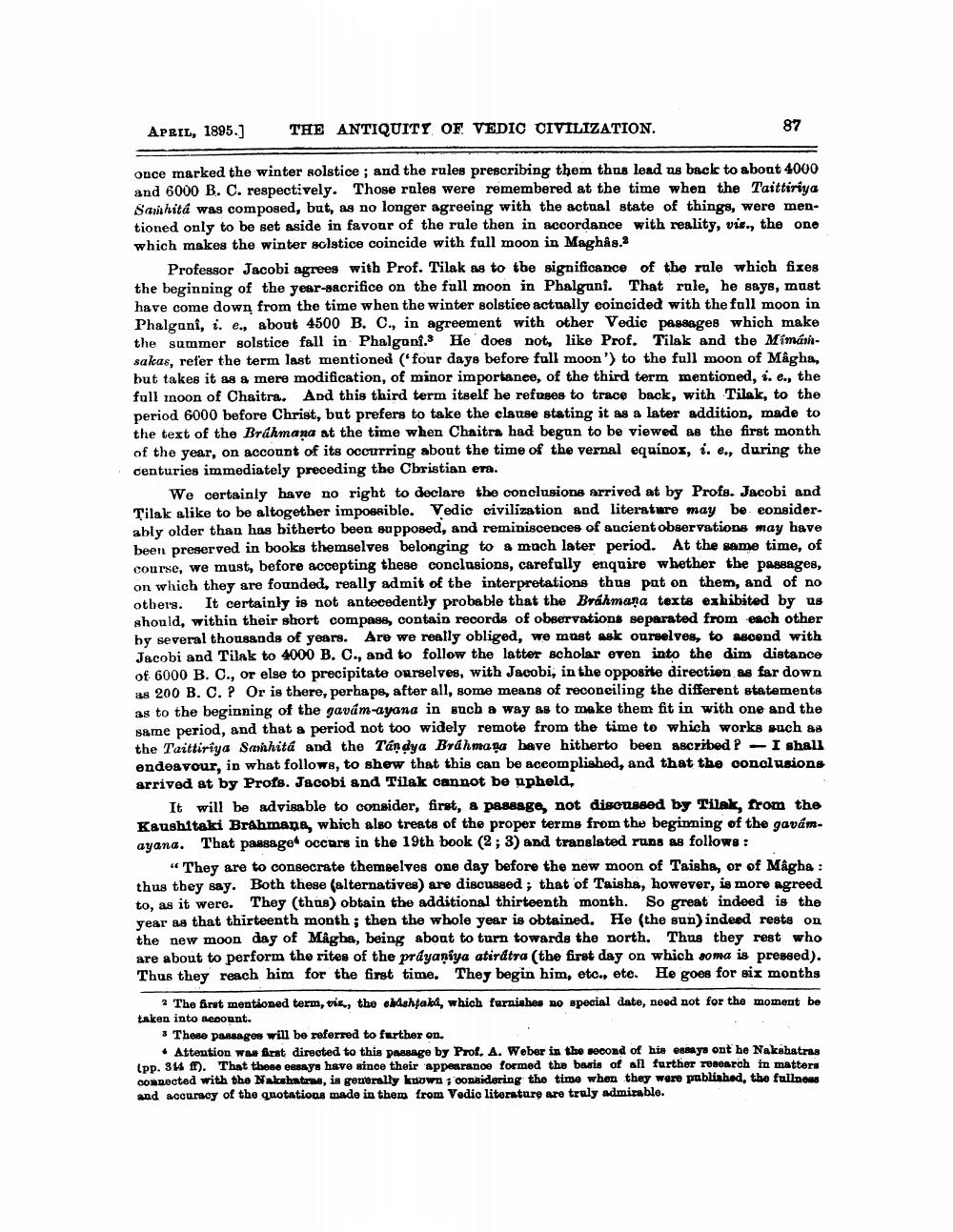________________
April, 1895.)
THE ANTIQUITY OF VEDIC CIVILIZATION.
87
once marked the winter solstice ; and the rules prescribing them thus lead us back to about 4000 and 6000 B. C. respectively. Those rules were remembered at the time when the Taittiriya Sanhita was composed, but, as no longer agreeing with the actual state of things, were mentioned only to be set aside in favour of the rule then in accordance with reality, vis., the one which makes the winter solstice coincide with full moon in Maghâs.3
Professor Jacobi agrees with Prof. Tilak as to the significance of the rule which fixes the beginning of the year-sacrifice on the full moon in Phalgani. That rule, he says, must have come down from the time when the winter solstice actually coincided with the full moon in Phalgani, i. e., about 4500 B, C., in agreement with other Vedie passages which make the summer solstice fall in Phalguns. He does not, like Prof. Tilak and the Mímánsakas, refer the term last mentioned ('four days before full moon') to the full moon of Magha, but takes it as a mere modification, of minor importance of the third term mentioned, i. e., the full moon of Chaitra. And this third term itself he refuses to trace back, with Tilak, to the period 6000 before Christ, but prefers to take the clause stating it as a later addition, made to the text of the Brahmana at the time when Chaitra had began to be viewed as the first month of the year, on account of its occurring about the time of the vernal equinox, i. e., during the centuries immediately preceding the Cbristian era.
We certainly have no right to declare the conclusions arrived at by Profs. Jacobi and Tilak alike to be altogether impossible. Vedic civilization and literature may be considerably older than has bitherto been supposed, and reminiscences of ancient observations may have been preserved in books themselves belonging to a much later period. At the same time, of course, we must, before accepting these conclusions, carefully enquire whether the passages, on which they are founded, really admit of the interpretations thus pat on them, and of no others. It certainly is not antecedently probable that the Brahmana texts exhibited by us should, within their short compass, contain records of observations separated from each other by several thousands of years. Are we really obliged, we must ask ourselves, to ascend with Jacobi and Tilak to 4000 B. C., and to follow the latter scholar even into the dim distance of 6000 B. C., or else to precipitate ourselves, with Jacobi, in the opposite direction as far down as 200 B. C.? Or is there, perhaps, after all, some means of reconciling the different statements as to the beginning of the gavam-ayana in such a way as to make them fit in with one and the same period, and that a period not too widely remote from the time to which works such as the Taittiriya Smhita and the Tándya Brahmaga have hitherto been ascribed ? - I shall endeavour, in what follows, to shew that this can be accomplished, and that the conclusions arrived at by Profs. Jacobi and Tilak cannot be upheld,
It will be advisable to consider, first, & passage, not discussed by Tilak. Grom the Kaushitaki Brahmans, which also treats of the proper terms from the beginning of the gavám. ayana. That passage occurs in the 19th book (2; 3) and translated runs as follows:
“They are to consecrate themselves one day before the new moon of Taisha, or of Mágha : thus they say. Both these (alternatives) are discussed ; that of Taisha, however, is more agreed to, as it were. They (thus) obtain the additional thirteenth month. So great indeed is the year as that thirteenth month; then the whole year is obtained. He (the sun) indeed rests on the new moon day of Mágba, being about to turn towards the north. Thus they rest who are about to perform the rites of the práyaniya atirdtra (the first day on which soma is pressed). Thus they reach him for the first time. They begin him, etc., ete. He goes for six months
? The first mentioned term, tis, the chishtabi, which furnishes no special date, need not for the moment be taken into account.
* These passages will be referred to further on.
• Attention wae Brat directed to this passage by Prof. A. Weber in the sound of his stays ont be Nakshatras (pp. 344 m). That these ensays have since their appearance formed the basis of all further research in matters connected with the Nakshatre, is generally known ; considering the time when they were published, the fullness and accuracy of the quotations made in them from Vedic literature are truly admirablo.




